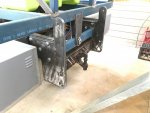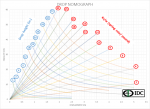Ramdough
Adventurer
Hi Ramdough. Well, all but the lock outs/hydraulic system are built. I have the two outer pivots no more than 100mm from the rear hanger of the front springs about 400mm behind the cab, keeping the cab and body faces in a fairly similar plane at all times. I have two central pivots, the first is located on the rear springs front hanger cross member and the second on the rear spring rear hanger cross member. These are all tack welded to the body and are yet to be fully welded. I've since added another central pivot at the very rear of the truck. All pivot points are on the center line of the chassis. I have then twisted the truck chassis (rear lh dual wheels 400mm off the ground) to the point where the lower lockers just touch the body to check that it all worked without any of the tack welds going bang, which it did. To double check what you mentioned about binding, I then unbolted and removed each locking bolt in the pivots and tapped each pin with the hammer to see how much load they were under. To my surprise they would tap out with ease and have minimal to no load on them. I must have got something right!Re the hydraulic setup, I have gone away from this due to weight, the time involved and cost to do it. I now plan to utilize 2 (poss 4) stumpy 100mm x 100mm coil springs between the body and chassis these will be sat with no or minimal tension when the truck is flat, and will only be compressed as the chassis twists. Here's a pic of the chassis twisted and the body straight. it was in this position that the pins would tap out.
View attachment 575883
Disclaimer: I am not the biggest expert on here, there are much smarter guys on this forum when it comes to the subframes.
So, are you say you have 3 central pivots now and a front fixed point? Are they urethane or solid bushings? A full picture would help.
Part of the problem is that if your pivots are not exactly at the neutral axis of your torsional stiffness, then they actually cause your pivots to translate sideways. It sounds like you have tried to hit the centroid with your design, but if you are off, each mount will move a different amount sideways. Also, twist is not the only direction that your frame bends. So now each pivots is trying to restrict the way your truck frame wants to bend.
Whatever you end up doing.... keep in mind that your flex test is under no load. Once you are fully loaded and flexing, you will twist and want to bow some too..... possibly in multiple places.
Sent from my iPhone using Tapatalk









